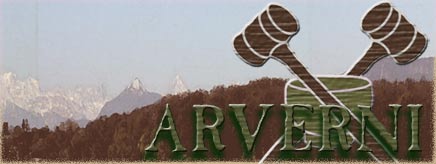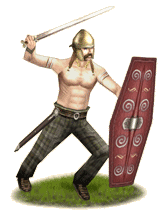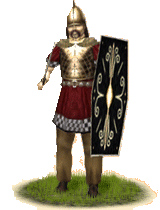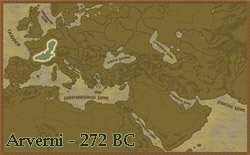Org Mobile Site

Of savage tribes and glorious empires
AAR-Conditions:
EB 1.2
Campaign Difficulty: VH
Battle Difficulty: M
Remark: I’m no historian, so forgive me if I misspelled names and squanderd historical locations of the tribes. I did my best.
 Prologue
Prologue 
Gallia was inhabited by many celtic tribes. In the north of those lands, tribes of the Belgae, namely the Nerves and the Bellovaces colonized the country. Those Celts, mingled with Germans, were known as the fiercest and most brave warriors of all. They struggled with great german tribes all the time and remained victorious. No gallic tribe, maybe except for the Helvetii, could praise themselves to be as courageous as the Belgae.
 Belgic Warrior
Belgic WarriorWestwards, down the sea coast the Aulerci lived in the land of Mrogaule and Armoriae was colonized by the Veneti. At the border to Aquitae, tribes of the Celts settled Lemorisae and the land they called Arvernotorg. These tribes were the Pictones and the Arverni, who built the great city of Gergovia.
Southwards from the Belgae, the land Sequallra was inhabited by the Sequani and Treveri, further southwards the Helvetians held their border against the Germans from the north, even invaded german territory from time to time, for which they were known as even braver than the other Celts, as mentioned before, they were considered to be at least as courageous as the Belgae. Between them and the Arverni the Segusiavi populated Lugonesis. In the middle of all those tribes, the Haedui built their city of Bibracte and called their land Mrogaedu.

Though the Celts were a quite progressive people, carried on commerce, were masters of rhetoric arts and used greek scripture, they loved war more than anything else. They left no opportunity past away to prove their bravery, and so for centuries the Gauls fought the Germans, the Romans, the Greeks and whoever crossed their way. But there was someone they preferred to fight even more! Themselves. The Celts fought each other at every occasion. They subjugated their neighbour tribes and let them fight for them, let them pay tributes and took hostages. During the last decades two power blocs formed, and fought each other to obtain superiority.
On one side the mighty Haedui have conquered the territory of the Aulerci and the Segusiavi in a swift and brutal war. From Viennos, the Haedui marched eastwards and conquered the city of Mediolanum. This was the greatest expansion of one gallic tribe ever seen.
On the other side, the Arverni declared themselves enemies of the Haedui and kept their land free of “Haeduism”. In several great battles they fought back their opponents armies, who now intended to go eastwards again and conquer the lands of the Helvetii. But they soon realised why the Germans did not manage to do so for centuries, and after a short but good thrashing the Haedui had to retreat.
Helvetian Warrior 

After those failings, the Segusiavi rebelled against their occupiers, joined with the Arverni and spured the Sequani, who have been their true allies for decades, into action. Now the league of the Arverni devided the territory of the Haedui into two parts. In the east there was the strong city of Mediolanum, in the west the union of Haedui and Aulerci.
Now the time came, when it had to be decided once and for all, who will rule the fate of celtic Gaul.
Map 272 BC

Nice start.
Good beginning.
Again good luck to it
Again good luck to it

Sweet. 

This should be good.
Oh and btw im keeping my warbands on teh borders.....just in case. (Insert Super Evil Laugh Here)
Oh and btw im keeping my warbands on teh borders.....just in case. (Insert Super Evil Laugh Here)
Nice start! And by the way, it's "Aedui", not "Haedui". 

Single Sign On provided by vBSSO